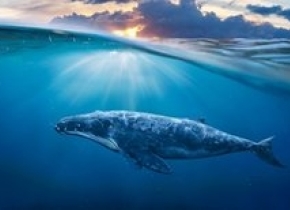

鲸类的祖先可能从来没有同时拥有过牙齿和鲸须,只有在尝试无牙生活和吮吸猎物后才发展出鲸须。
撰文\播音:安妮·斯尼德Annie Sneed
翻译:邱燕宁
审校:张清越
Baleen whales are the gentle giants of the sea. Despite their colossal size, they feed on tiny creatures such as krill and zooplankton. That’s because these whales, instead of teeth, have bristle-like structures in their mouth—baleen—which filters out small critters from big gulps of water. But the ancestors of baleen whales had a very different diet.
须鲸是海洋中温和的庞然大物。尽管它们体型庞大,但它们只以磷虾和浮游动物等微小生物为食。这是因为这些鲸类口中,类似刚毛结构的鲸须取代了牙齿,而这些鲸须能从大量的水中过滤出微小的生物。但是须鲸的祖先们却有着非常不同的饮食。
“So, the oldest whales that we know—these are the ancestors not just of the great whales like the blue whale and the humpback whale, but also of all of the dolphins in the sea today—they had fairly big teeth.”
“我们知道的最古老的鲸鱼——不仅是蓝鲸和座头鲸等大型鲸鱼的祖先,而还是如今海里所有海豚的祖先——它们的牙齿相当大。”
Felix Marx, a postdoctoral research fellow at the Royal Belgian Institute of Natural Sciences.
菲利克斯·马克思,比利时皇家自然科学研究所博士后研究员说。
“And the most common idea is that they ate relatively large fish, and for some of the biggest ones… there are some studies that looked specifically of the wear of those teeth at the microscopic level, and they seem to suggest that they ate almost anything that they came across. The point is that they had big teeth that were really sharp, and that were even, relative to the size of their jaws, were relatively large, so they were really predators.”
“最普遍的观点是,它们吃的是相对较大的鱼,甚至一些最大的鱼……有一些研究专门检查了这些牙齿在显微镜下的磨损程度,这些研究似乎表明,它们几乎吃了遇到的任何东西。关键在于它们的牙齿非常锋利,而且即使相对于它们的下颚的尺寸来说,它们的牙齿也是相当大的,所以它们是真正的掠食者。”
So where did baleen come from? Marx and his colleague Ewan Fordyce set out to answer this question. They analyzed the mouth of a 34-million-year-old fossil of one of the earliest baleen whales, called Llanocetus denticrenatus, found in Antarctica. And they concluded that Llanocetus had sharp teeth and large gums—but no baleen.
那么须鲸是从哪里来的呢?马克思和他的同事伊万·弗迪斯想着手回答这个问题。他们分析了一块3400万年前的鲸类口部化石,这块化石是在南极洲发现的最早的须鲸之一,名为兰头鲸。他们得出结论,兰头鲸有锋利的牙齿和巨大的牙龈,但没有鲸须。
Their findings argue against one of the ideas about how baleen evolved—that at some point whales had both teeth and baleen. “Llanocetus is the first and it’s the only specimen, the only species, the only archaic whale, that makes a very clear case that, no, this coexistence of baleen and teeth, as it was just imagined basically…based on what modern whales looked like, didn't work. It didn't exist in that sense.” The finding is in the journal Current Biology. [R. Ewan Fordyce and Felix G. Marx, Gigantism Precedes Filter Feeding in Baleen Whale Evolution]
他们的发现反驳了关于鲸须是如何进化的一种观点——那就是,在某个时间点,鲸既有牙齿又有鲸须。“兰头鲸是第一个也是唯一一个标本,唯一的物种,唯一的古老的鲸鱼,它清楚地证明了,不,这种长须鲸和牙齿的共存,基本上是基于现代鲸鱼的样子想象出来的,而这是行不通的。从这个意义上说,它并不存在。”这一发现发表在《当代生物学》杂志上。
So how did some whales go from chomping predators to filter feeders? “Baleen is effectively an outgrowth of the gums, and that probably only happened once the teeth had already been lost or maybe had been severely reduced. So we suggest this intermediate phase where you start with teeth and biting, then you start sucking your food, then because you suck in small things, you start to develop a filter and eventually you become a proper filter feeder.”
那么,一些鲸鱼是如何从咀嚼捕食者变成过滤捕食者的呢?“鲸须实际上是牙龈发育而来的,这种情况可能只有在牙齿已经脱落或严重脱落时才会发生。”所以我们认为这个中间阶段从用牙齿咬东西开始,继而开始吮吸食物,后来因为吮吸小的东西,渐渐发展出一个过滤器官,最终成为一个合适的滤食者。”
 京公网安备11010502039775号
京公网安备11010502039775号